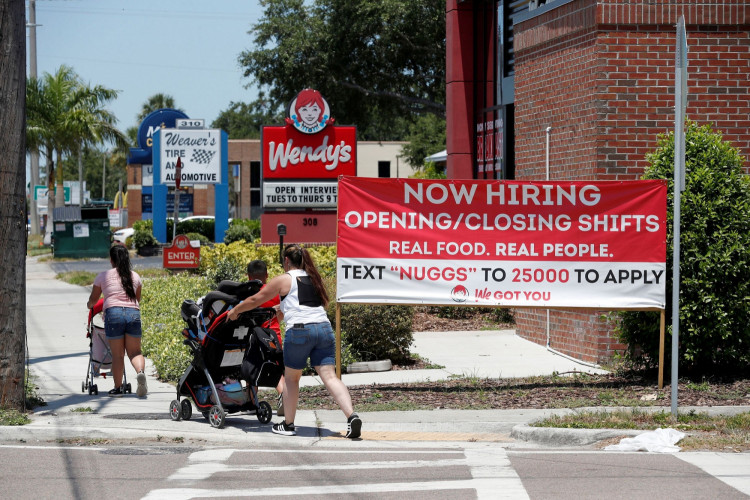The U.S. labor market delivered its weakest job growth in nearly three years, with October's job additions totaling just 12,000, a stark decline from September's revised gain of 223,000, the Bureau of Labor Statistics (BLS) reported Friday. This sharp deceleration in hiring-falling significantly below economists' forecasts for 100,000 new jobs-comes as severe weather and a protracted Boeing strike weighed heavily on economic activity.
Despite the slowdown in job creation, the unemployment rate held steady at 4.1%, matching analyst expectations. A broader unemployment measure, which includes discouraged workers and those in part-time jobs for economic reasons, remained unchanged at 7.7%. Lisa Sturtevant, chief economist at Bright MLS, described the report as casting a "murky shadow heading into next week," as the nation prepares for the November 5 presidential election, where economic stability is a central theme in the tight race between Vice President Kamala Harris and former President Donald Trump.
The October report highlighted the disruptive impact of labor disputes and natural disasters on the labor market. The BLS noted that the nearly two-month Boeing strike likely eliminated around 44,000 manufacturing jobs. In total, the manufacturing sector lost 46,000 jobs, signaling a wider deceleration in industrial hiring, exacerbated by the strike. Adding to these woes, hurricanes Helene and Milton struck the Southeast, particularly affecting Florida and North Carolina, though the BLS stated it could not isolate the net effect of these events on overall employment numbers.
Boeing's labor stoppage is expected to end soon, potentially relieving some of the strain on the job market. The aerospace giant's strike, involving around 44,000 workers, sidelined production, impacting employment figures significantly. "Manufacturing declines in October were largely due to strike activity," the BLS noted, underscoring the ongoing vulnerability of the sector to industrial actions.
In addition to losses in manufacturing, several sectors posted declines, further dampening an already struggling jobs market. Temporary help services, often viewed as a bellwether for broader employment trends, shed 49,000 positions in October, bringing the category's job losses to 577,000 since March 2022. Leisure and hospitality, retail trade, and transportation and warehousing also saw modest declines, raising concerns about underlying softness in sectors sensitive to consumer spending and economic conditions.
The BLS report offered a few bright spots, however. Health care and government hiring provided some support, adding 52,000 and 40,000 jobs, respectively. Nonetheless, overall job growth remains muted, with the 2024 monthly average job gain dipping to around 200,000-down from last year's pace but still viewed as consistent with a resilient labor market by some analysts.
Wage growth was slightly higher than expected, up 0.4% for the month, matching the September increase and pushing the annual gain to 4.1%. Though still moderate, the increase in wages is closely watched by Federal Reserve policymakers for signs of inflationary pressure. The average workweek remained steady at 34.3 hours, providing a semblance of stability in otherwise lackluster data.
Markets responded swiftly to the subdued report, with Wall Street anticipating the potential for further monetary easing by the Federal Reserve. Stock futures rose, while Treasury yields dropped, as investors priced in a nearly certain rate cut at the Fed's upcoming policy meeting. The central bank's rate-setting Federal Open Market Committee (FOMC) is widely expected to announce a quarter-point rate cut next Thursday, following an unprecedented half-point reduction in September.
The downbeat October data also included substantial downward revisions to prior months, with August's job gains revised down to 78,000 and September's tally lowered by 23,000. Combined, these adjustments reduced previously reported job creation by 112,000, adding to the sense that the labor market may be softening more than initially thought.
Economists caution that while October's report reflects specific disruptions from strikes and weather, it may also signal a gradual deceleration as the Federal Reserve's high-interest rate environment begins to bite. The Fed's aggressive tightening over the past two years has moderated inflation but raised concerns about the potential for slower economic growth and rising unemployment.
Joe Brusuelas, chief economist for RSM, suggested taking a broader view beyond the weak job number, stating, "Ignore that top line [job additions], look at that 4.1% and just get on with it...this is all noise." However, other economists see signs of caution, particularly with labor force participation, which ticked down slightly to 62.6% in October.
As the nation heads into the final stretch of the 2024 presidential campaign, the economy's performance is likely to dominate political discourse. Both candidates, Vice President Kamala Harris and former President Donald Trump, have made economic recovery a central pillar of their platforms. The light job gains and Boeing's high-profile strike underscore the complex challenges in balancing robust employment growth with economic stability.






